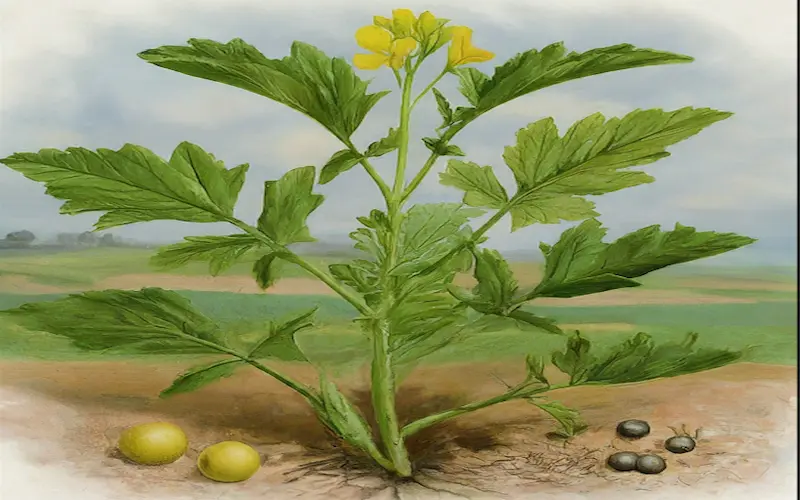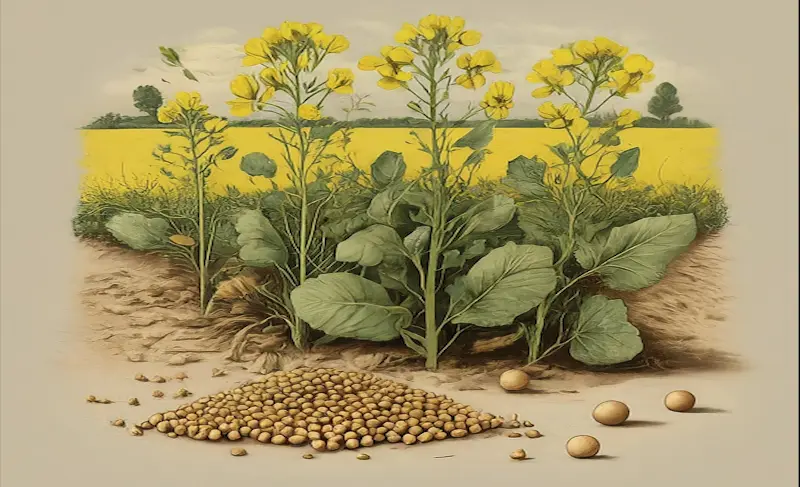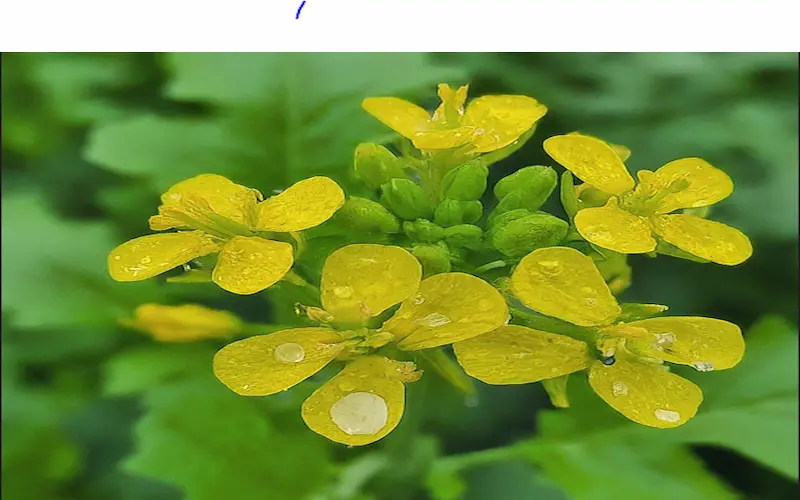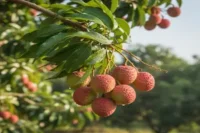Mustard Crop Cultivation: Plant for Greens or Cover Crop – Complete Guide
Published: 3 Aug 2025
As a farmer, I have always been fascinated by the diverse range of crops that can be cultivated. One crop that has caught my attention in recent years is mustard. Mustard agriculture, also known as mustard farming, has gained popularity steadily due to its numerous benefits and versatile nature. In this article, I will delve into mustard agriculture, exploring its benefits, statistics, farming techniques, market demand, and the challenges mustard farmers face. Join me as we unlock the potential of the mustard crop.

Benefits of Mustard Agriculture
Mustard agriculture offers a multitude of benefits that make it an attractive choice for farmers:
- Mustard crops are known for their high oil content, making them a valuable source of edible oil.
- Mustard oil is also used in the cosmetic industry, further enhancing its market demand.
- Mustard plants have deep roots that help improve soil structure and prevent erosion, making them an ideal choice for sustainable farming practices.
Furthermore, mustard crops can act as natural pest repellents, protecting neighboring plants from harmful insects and pests. This natural pest control aspect of mustard agriculture reduces the need for chemical pesticides, making it an environmentally friendly choice. Lastly, mustard plants have been found to possess biofumigation properties, which help suppress soil-borne pathogens and diseases, benefiting the soil’s overall health.

Mustard Agriculture Statistics
The statistics surrounding mustard agriculture are a testament to its growing popularity. According to recent data, mustard is the world’s third most important oilseed crop, with a global production of over 75 million metric tons annually. India is the largest producer of mustard, contributing to more than 40% of the world’s output. The increased demand for mustard oil domestically and internationally has fueled the expansion of mustard farming in various regions.
Regarding cultivation area, mustard crops cover approximately 8 million hectares worldwide, with India accounting for nearly half of the total area. The favorable climatic conditions and availability of suitable land make India an ideal destination for mustard farming. The rising awareness of the health benefits associated with mustard oil has also contributed to the surge in mustard agriculture.
Mustard Crop Life Cycle and Duration
Understanding the life cycle and duration of the mustard crop is crucial for successful cultivation. The mustard crop goes through various stages, from seed germination to maturity. The life cycle of a mustard plant typically spans around 90 to 120 days, depending on the variety and environmental conditions.
The first stage is seed germination, where the mustard seeds absorb water and sprout. This is followed by the vegetative stage, where the plant grows leaves and stems. Next is the reproductive stage, characterized by the formation of flowers. The flowers eventually give rise to pods, which contain the mustard seeds. Finally, the crop reaches maturity, and the pods turn brown, indicating the seeds are ready for harvest.

Mustard Farming Techniques and Best Practices
Mustard farmers employ various techniques and best practices to achieve optimum yields and quality. One crucial aspect is soil preparation. Mustard crops thrive in well-drained soil with a pH of 6.0 to 7.5. Adequate soil moisture is essential during the initial stages of growth, and regular irrigation is required throughout the crop’s life cycle.
Proper weed management is also crucial in mustard agriculture. Weeds can compete for nutrients, sunlight, and water, hampering the growth of mustard plants. Farmers employ various methods, such as manual weeding, herbicide application, and crop rotation, to control weed infestation effectively. Additionally, timely and appropriate fertilization is necessary to ensure the healthy growth of mustard crops.

Mustard as a Rabi Crop
Many farmers wonder whether mustard is a rabi crop or a kharif crop. Mustard is primarily grown as a rabi crop, which means it is sown in winter and harvested in spring. The cool weather during the winter months is favorable for the growth of mustard plants. However, specific varieties of mustard can be cultivated as a kharif crop, depending on the region and climatic conditions.
In the rabi season, mustard crops are sown between October and November, and harvesting occurs between February and March. The longer duration of the crop allows farmers to plan their cultivation schedule effectively. Additionally, the rabi season also provides a window of opportunity for crop rotation, ensuring the overall health of the agricultural ecosystem.
Mustard as a Kharif Crop
While mustard is primarily a rabi crop, it can also be cultivated as a kharif crop in specific regions. The kharif season refers to the summer months, where crops are sown at the onset of the monsoon season. In areas with suitable rainfall patterns and temperatures, farmers can opt for kharif mustard cultivation. However, selecting the appropriate mustard varieties suitable for Kharif conditions is essential.
Kharif mustard crops are sown between June and July and harvested between September and October. The shorter duration of the crop allows farmers to make the most of the available growing season. However, proper irrigation and water management become crucial during the kharif season to ensure the healthy growth of mustard crops.
Mustard Farming in Hindi
Mustard farming, or “Sarson ki Kheti,” commonly known in Hindi, has deep roots in Indian agriculture. Mustard is an integral part of Indian cuisine and culture, making its cultivation a significant aspect of farming in India. The Hindi language has specific terms and practices associated with mustard farming, reflecting the deep knowledge and expertise of Indian farmers.
In Hindi, mustard plants are referred to as “sarson ke paudhe,” and mustard seeds are known as “sarson ke beej.” Farmers in Hindi-speaking regions follow traditional methods of mustard farming, which have been passed down through generations. The cultural significance of mustard in Hindi-speaking areas has contributed to the growth and sustainability of mustard agriculture in India.

Mustard Crop Varieties and Seeds
The mustard crop encompasses various varieties and seeds, each with unique characteristics and adaptability. Some popular mustard varieties include Indian mustard (Brassica juncea), yellow mustard (Sinapis alba), and brown mustard (Brassica nigra). These varieties differ in taste, oil content, and suitability for specific climatic conditions.
When selecting mustard seeds, farmers consider factors such as maturity duration, disease resistance, and oil content. Hybrid seeds are also available, offering higher yields and improved disease resistance. Farmers must choose a suitable variety and seed quality to ensure a successful mustard crop.
Mustard Crop Market and Demand
The demand for mustard crops and products is rising, driven by various factors. Mustard oil, known for its unique flavor and health benefits, is widely used in cooking and food preparation. The demand for mustard oil is exceptionally high in India, Bangladesh, and Nepal, where it is a staple in many regional cuisines.
Besides its culinary uses, mustard oil is also extensively used in the cosmetic industry. The natural moisturizing and rejuvenating properties of mustard oil make it a popular ingredient in skincare and haircare products. The increasing consumer preference for organic and natural products has further boosted the demand for mustard oil.
Mustard Agriculture Challenges and Solutions
While mustard agriculture offers numerous benefits, it has its fair share of challenges. One of the primary challenges is the susceptibility of mustard crops to pests and diseases. Mustard aphids, white rust, and Alternaria blight are common problems mustard farmers face. Integrated pest management practices, crop rotation, and disease-resistant varieties can help mitigate these challenges.
Another challenge in mustard farming is the fluctuating market prices. The profitability of mustard crops is influenced by various factors such as weather conditions, global oilseed prices, and government policies. Farmers can overcome this challenge by adopting efficient marketing strategies, exploring value-added products, and participating in farmer cooperatives.
Conclusion
Mustard agriculture has emerged as a promising and lucrative option for farmers worldwide. The numerous benefits, increasing market demand, and adaptability of mustard crops make it an attractive choice for sustainable farming practices.
By implementing best practices, addressing challenges, and staying updated with the latest research and technologies, mustard farmers can unlock the full potential of this versatile crop. So, whether you are a seasoned farmer or someone considering venturing into the world of agriculture, I encourage you to explore the possibilities of mustard crop farming and reap its rewards.

- Be Respectful
- Stay Relevant
- Stay Positive
- True Feedback
- Encourage Discussion
- Avoid Spamming
- No Fake News
- Don't Copy-Paste
- No Personal Attacks



- Be Respectful
- Stay Relevant
- Stay Positive
- True Feedback
- Encourage Discussion
- Avoid Spamming
- No Fake News
- Don't Copy-Paste
- No Personal Attacks



